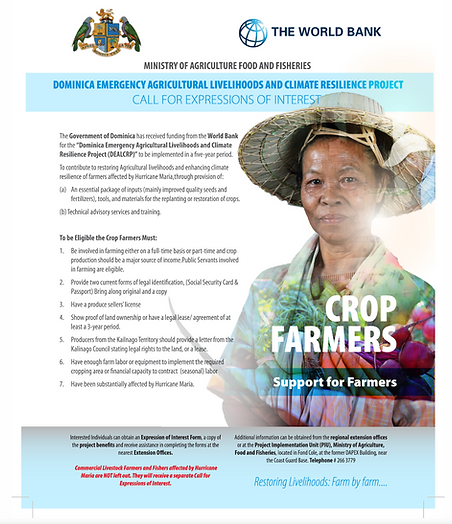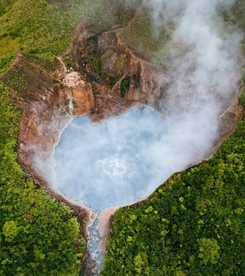
Growth of the Private Sector
Growing the private sector in Dominica is important for two main reasons I have identified: increasing employment opportunities and reducing an individual’s financial vulnerability that would be strained after a climatic event. This section will focus on how Dominica’s private sector has improved since Maria, while offering some critique over critical industries the government has not adequately targeted.
Tourism
Like the rest of the Caribbean, Dominica relies heavily on tourism for economic growth. The "Nature Isle" of the Caribbean relies on its natural scenery to engulf visitors in adventure. Tourists can dive into nature with the island's many nature exploration tours.
Beyond just the natural scenery is the beautiful attraction of the people and the culture that exists on the island. Dominica's rich Creole culture is evident in its music and cuisine. Dominica hosts many festivals to draw in crowds, mainly from other islands in the region and other Caribbean nationals in the diaspora.
 |  |  |
|---|---|---|
 |
Hurricane Maria hit the tourism industry particularly hard by damaging a significant portion of the island's hotel room stock and tourist site attractions. The sector was hit hard again a few years later with the global coronavirus pandemic in 2020. During the Covid-19 pandemic, due to travel restrictions, Dominica experienced a significant plunge in tourism, making the resort industry more vulnerable.
Colin Piper, the CEO of Discover Dominica Authority and Director of Tourism, spoke to me briefly in an interview about how Dominica has responded to these significant disrupters to the industry. Discover Dominica helps to promote and advertise Dominica's tourist attractions. It helps to organize events and festivals that draw in large crowds.
In the aftermath of Maria, there was concern about the room supply stock and the tourist sites that had been damaged. The most important priority for Discover Dominica was to be transparent with the press by giving frequent briefs updating the island's state and when the island would reopen for tourism. One of the major inhibitors to the reopening process of the industry is the number of people that were either self-insured or underinsured. Many insurance companies on the island also found themselves underinsured; there was not enough money for all the payouts filed .

The government was taking its part in helping to rehabilitate the industry by restoring infrastructure needed for tourism. The government ensured the roads were navigable, restoring electricity and water access, and clearing debris from sites. It only took 90 days for Dominica to open for tourism again. Still, it took a little longer to get the message that Dominica was ready again. It was challenging to get the attention of travelers due to the competition from other tourist islands, such as Barbados, that were not as severely hit.
Only a few years after the industry reopened, the coronavirus threw the world into a global pandemic, shutting down all vacation plans. During the pandemic, some of the islands in the Caribbean readjusted their approach by targeting professionals working remotely to live on the island for an extended period. Dominica formed the Work in Nature (WIN) Program inviting remote workers and digital nomads to trade their stressful and restrictive working environments for the rejuvenating beautiful island life for 18 months. Individuals would have access to Dominica's transportation system, hospitals, and schools for children while participating in the program. Additional benefits to the program include:
-
income tax waiver,
-
duty-free concessions on imported personal effects,
-
the ability to apply for an annual driver's license,
-
and free travel during the visa period.
Covid-19 offered Discover Dominica new ways to attract tourists through the WIN program. The organization looks to continue the program while streamlining it and making the application process more effortless .
Once the world reopened after the pandemic, the stars began aligning for Dominica, said Colin. After Covid canceled people's travel plans and people were stuck in their homes for a long time, there was a flood of people eager to travel again. Dominica's nature-filled, outdoors, and wellness-centered lifestyle attracted many travelers. Discover Dominica collaborated with a public relations agency based in the U.S. to help them pitch what Dominica has to offer to the writers and editors of travel magazines. Soon, many notable magazines, such as Forbes, CNN, Lonely Planet, and Times Magazine, were all talking about Dominica. Dominica quickly became a "must-visit" tourist destination.

“‘2023 is shaping up to be an exciting year to get out and explore. With much of the world firmly on the road to recovery, travellers are looking for different locations and experiences, and we know Dominica will not disappoint,’ says Tom Hall, vice president of Lonely Planet.” – Forbes Magazine December 22, 2023

Red Rocks shot by Daniella Rolle
Agriculture
As previously mentioned, Dominica's agricultural sector experienced significant damage after Hurricane Maria. The vulnerability of Dominica’s agricultural industry is not only limited to climatic events, such as hurricanes or droughts, but also to the changes in the international markets to which their produce is exported.
Agriculture has historically played a central role in Dominica’s economy, specifically crop production for export. Historically, the agriculture sector has been geared towards monoculture. Beginning with colonialism and the prevalence of sugar cane plantations, the market then shifted to coffee, lime, vanilla and bananas. Bananas, being a major cash crop from the island, played an essential role in shaping Dominica's economy in the 20th Century. By the 1960's, the banana industry accounted for just under 80% of all exports. However, the banana leaf spot disease in 1978 and Hurricane David in 1979 resulted in a significant drop in production due to loss of plants causing a massive blow to the industry. Rehabilitation efforts led to a surge in production, but within a decade the European Single Market was established and threatened the banana trade. Changes in Eastern Europe after the fall of communism also functioned to redirect foreign aid away from the Caribbean, making the island incredibly vulnerable to external changes.
Following the demise of the banana industry, Dominica emphasized developing a more diversified agricultural sector, focusing on root and tree crops and vegetables. Diversification was geared at supplementing the loss of earnings from the banana sector. However, these efforts were dealt a heavy blow following the passage of Hurricane Maria. The effect on the sector was so impactful that it realized its lowest growth rate in respect to GDP in 2018.
Image from Dominica News Online
Talking to Anthony Cyrille, a CREAD team member whose role focuses on climate resilient agriculture, helped me understand how Dominica has worked since 2017 to rehabilitate the sector. One major intervention post Hurricane Maria aimed at resuscitating the agriculture sector is the World Bank Funded Emergency Agricultural Livelihoods and Climate Resilience Project (EALCRP). This project seeks to modernize the agriculture sector, increase productivity on farms, and incorporate climate resilience in the sector to include food and no-food systems. This project has an overall budget of USD $28.6M and entails four core components:
-
Restoration of the Productive Base for the Recovery of Agricultural Livelihoods
-
Restoration of Key Productive Infrastructure and Institutional Strengthening
-
Project Management and Coordination
-
Contingency Emergency Response Component

The Ministry of Agriculture has also contributed by educating farmers on sustainable practices such as soil and water conservation techniques. Anthony Cyrille mentioned that encouraging sustainable practices would focus on production systems rather than reverting to a monocrop for purely economic returns. Production systems would encourage farming along the contours of steep slopes, using crops to protect ground cover to prevent water runoff, and growing crops with deep root systems to hold the soil together.
Due to Dominica's diverse landscapes, innovative and current climate smart technologies are required to ensure the competitiveness of the agricultural sector. These practices will need to be tested to demonstrate their effectiveness under local conditions. Anthony Cyrille mentioned one such initiative; the installation of weather stations strategically aligned with the microclimatic zones which will provide more accurate weather reporting for farmers. Farmers will then be able, with the help of trained meteorology personnel, to determine the trends in weather patterns and decide the suitable crops to be planted. Other interventions can be applied to mitigate against excessive rainfall or temperature.
Greater progress can be made in utilizing technological resources in farming techniques by collecting more data on soil quality at the farm level for farmers to better understand sustainable agricultural practices specific to their farms. As mentioned in the previous section, through data collaboration and open-source databases, farmers can access data that may affect their farms, such as stream levels and soil quality, and can make better-informed decisions.
Technological innovations to assist farmers in communicating with potential buyers through a cell phone app have even begun. The app has already been developed and is in the testing phase.
More sustainable growing practices also aid Dominican farmers in having an edge in international markets helping promote Dominica's brand of being the 'Nature Isle.' With free trade, the countries that can produce the cheapest products have a greater advantage. Dominica's size and terrain prevent farmers from having large-scale agricultural lands like their competition in Latin America and larger islands in the Caribbean who also have an ample supply of cheap labor. Anthony Cyrille spoke on how Dominica attempts to circumvent the disadvantage by occupying space in the fair trade, organic and sustainably produced markets abroad. They mainly target the markets in the Northern Caribbean, neighboring islands, Europe (especially the U.K.), and some in the U.S.




To build up the agricultural sector, continuing the emphasis on training farmers through programs on more sustainable practices is imperative to sustain the industry's growth. It is also crucial for Dominican farmers to be able to leverage this education in their marketing strategies in the organic and fair trade international markets. Encouraging farmers to use the app to connect them with local buyers is equally important in encouraging residents to buy local goods. Finally, realizing the tremendous potential for technology in the agricultural industry can aid farmers in building more dynamic systems that prepare them for climatic changes.

Soufriere shot by Daniella Rolle
Micro, Small, Medium Sized Enterprises (MSMEs)
Dominica's entrepreneurs mostly fall within the MSME category, with many primarily catering to services on the island rather than expanding their market abroad. Part of CREAD's commitment to supporting a robust economy is to assist these small businesses. CREAD's goal is a "minimum target of 5% sustained, sustainable and inclusive economic growth by 2030" (CREAD, 2022).
One of the key programs Elijah Leblanc, MSME Business Advisor at CREAD, has worked on to achieve this goal is a database that collects information on businesses on the island. Elijah Leblanc had the idea of making the database after realizing there was no data on how many small businesses were on the island. He collaborated with students at the Dominica State College to use various methods to collect data on businesses across the island. Due to the numerous cottage companies (run outside of a home or small vendor), they sectioned the island into zones. Students walked in each zone to find visible businesses and asked people if they knew of any more businesses nearby. The team conducted surveys on the ground, over the phone, and over email to collect the data to build the database. CREAD also collaborated with the Companies and Intellectual Property Office (CIPO) to obtain a business list that would help narrow the targeted businesses more efficiently. A little less than 1,000 businesses (959 to be exact) were captured in the database.
Scenes from the Bayfront in Roseau shot by Daniella Rolle





The database can be a tool to provide targeted interventions to benefit the sector. The data can help stakeholders understand the market's strengths and weaknesses. It can also serve to inform policy decisions and lenders based on market trends. Data also provides insights into the geographical location of businesses to assess potential vulnerabilities (e.g., flood-prone regions, landslides, etc.). Data collection on businesses also allows for more information on the demographics of the business owners — their gender, age, and whether they have any disabilities. More information on whether these businesses have insurance coverage can help inform if insurance is valued for businesses on the island, considering a part of resilience is the need for coverage in the event of a disaster. Capturing this data is also helpful for information for donor organizations that want to make targeted interventions in the economy (e.g., support female-owned businesses). With CREAD coming to a dissolution at the end of 2023, the Small Business Support Unit (SBSU) will take over the ownership of the database. The Information and Communication Technology Unit (ICT), who helped on the technical end to build the database, will be responsible for maintenance duties .
In addition to the database, Elijah Leblanc has also worked to create a MSME Business Guidebook to provide business management training and content. Eleven experts in the field volunteered to help to develop an outline for the course and syllabus. The handbook aims to give small business owners the fundamentals for managing their businesses efficiently, increasing their performance, keeping records properly, and knowing how to comply with regulations. Some of the training includes developing emotional intelligence for managers to better manage their employees and for their benefit. Lessons on standards for packaging, labeling, and presenting their products to comply with standards are also included. With the handbook, Elijah Leblanc hoped to assist businesses in implementing best practices and fostering a culture of customer service for both startups and existing businesses.

Growth in the MSME sector provides greater employment opportunities, especially for the under-educated population, which is crucial for financial security for business owners on the island. Collecting more data on the businesses that exist here offers opportunities to address the vulnerabilities of different types of business and even their location to be better prepared for climatic events. Fostering better management practices also equips business owners with the tools for climate readiness and disaster preparedness.
Importance of the Tech Industry
Resilience must include the Dominican government investing heavily in diversifying the economy with highly-resilient and profitable industries for young entrepreneurs. A primary example of this would be the technology industry. Craig Nesty mentioned in the interview that he believes the Dominican government cannot fully conceptualize the profit in tech, which is a large reason why the government fails to provide sufficient assistance to tech entrepreneurs. Tech entrepreneurs depend on venture capitalists to help them develop until they can make a profit. However, it is difficult to get funding because they have no collateral. Commercial viability must also be considered because of the small market in Dominica. Reaching a scale that can make the venture profitable may require having a market in the millions which is a challenge when Dominica's population is only approximately 70,000 people.
With the limited support from the government for the tech industry, Craig Nesty suggested that the only solution would be to work for companies in the U.S. remotely on the island. Working for companies abroad remotely from Dominica can also provide an avenue for tech specialists and engineers to gain more experience working on projects. With more experience they are more likely to be selected as contractors on development projects funded by international organizations working in Dominica.


















